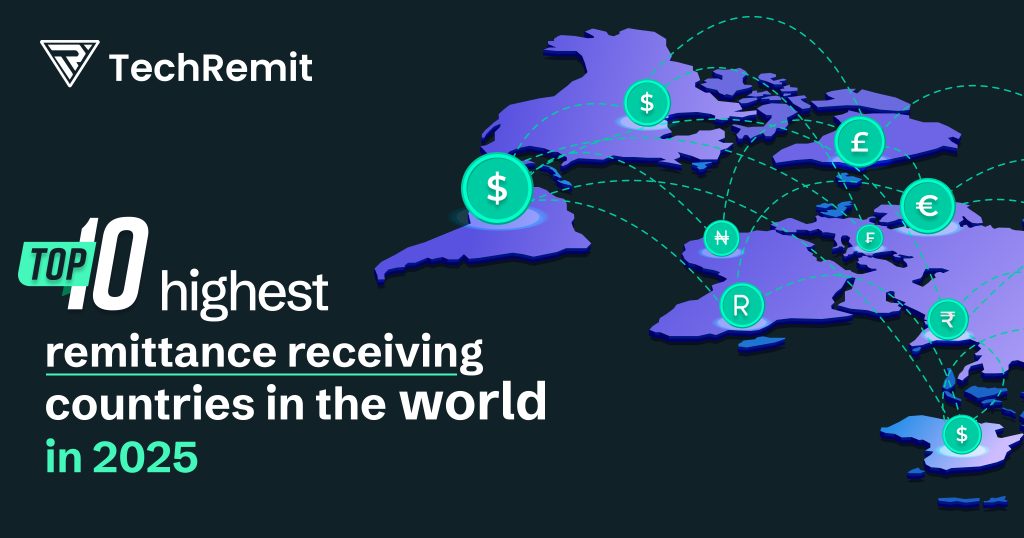Top 10 Highest Remittance-Receiving Countries in the World

The flow of remittances has increased in the past few years. These international money transfers are not only crucial for people to support their families in their home countries but also assist in improving national economies and carrying out business transactions.
In fact, remittances support from a quarter to around half of GDP for low- and middle-income countries such as Tonga (49.9%), Lebanon (37.8%), and more. Thus, remittances help these countries improve nutrition, reduce poverty, and cover the basic needs of citizens. Due to such a bigger impact of remittances, global remittance flow is predicted to reach $913 billion by the end of 2025.
We have a curated list of the top 10 remittance-receiving countries as per the latest data. Let’s take a look!
India
India has maintained its position at the top of the list for years, with an estimated flow of $129 in 2024. Also known as Bharat, the country received 14.3% of global remittances. Such a massive figure is achieved due to the large number of Indians working in industries like tech and healthcare in foreign countries. Most of these funds come from countries like the United States, Saudi Arabia, and the United Arab Emirates. Although India ranks first in remittance inflows, the contribution of these funds to the country’s GDP is relatively low compared to smaller economies.
Mexico
Mexico ranks second on this list, summing $68.2 billion in remittances in 2024. Remittances account for nearly 4.5 percent of Mexico’s total GDP. It was the year 2021 when Mexico overtook China on the list of chief beneficiaries of global remittance transfers.
Sectors like agriculture, construction, and services in the United States have hired a large number of Mexican laborers. Thus, over 95% of all money transfers sent to Mexico are from the U.S.
China
With over $48 billion transferred, the People’s Republic of China ranks third on this list. Additionally, China has one of the largest populations of expatriates in the world.
Most remittance flow is transmitted from countries like the U.S., Hong Kong, South Korea, and Japan. Despite this, the economy of China doesn’t heavily depend on remittances (<1% of GDP), since the service sector makes up 56.8% of the total GDP. Also, the industrial sector follows at 36.5%, with agriculture contributing 6.8%.
Philippines
Recently, it was estimated that the Philippines received $40 billion in 2024. Just like for India, Mexico, and China, the United States is the principal source of international money transfers to the Philippines as well. Apart from that, Saudi Arabia and Europe also contribute significantly to these cross-border financial transactions to the Philippines.
Overseas Filipino Workers (OFWs) send this money to support the needs of their families and cover their basic daily needs, education, healthcare bills, and more.
Pakistan
Pakistani immigrants sent around a tally of $33 billion in remittances in 2024 to this country. It particularly received money from the Gulf countries: Bahrain, Qatar, Saudi Arabia, Kuwait, Oman, and the United Arab Emirates. Supporting the country’s economic stability, this remittance flow contributes around 8-10% of GDP.
France
France experienced an influx of foreign capital estimated at around $30 billion from French immigrants in 2024. In fact, this European country received $3.7 billion in digital remittances in 2022. It has positioned itself among the leading countries opting for online remittance platforms. In 2027, this figure is expected to reach even more at $5.17 billion.
Bangladesh
Bangladesh is the world’s seventh most populous country, and it ranks seventh in terms of top remittance recipient nations as well. It was found that it received an estimated $26.6 billion in 2024. With remittances accounting for approximately 6-7% of GDP, this capital plays an important role in poverty reduction and economic development in Bangladesh. Not to mention that the service and agriculture sectors continue to be the largest contributors to Bangladesh’s GDP.
Egypt
Home to the world’s oldest civilization ever to exist, Egypt is among the top remittance-receiving nations, tallying $22.7 billion in 2024. While the government is making significant efforts to tackle the country’s poverty rate, which currently stands at 40%, international money transfers play a solid role in alleviating poverty and reducing unemployment.
Germany
In 2024, Germany received $23 billion in remittances, placing it second-last among the chief beneficiaries of global remittance transfers. Even though the country is among the top recipients of remittances, remittances only make up 0.5% of its GDP, whereas the service and industrial sectors contribute roughly 70% and 29.01%, respectively.
Nigeria
Nigeria is the leading recipient of remittances on the African continent and is ranked last among the top remittance recipient countries in 2024. It was tallied that $20.98 billion would flow into the country through remittances in 2024. These numbers have increased from $19.1 billion in 2021. Households, along with the nation as a whole, benefit financially from cross-border money transfers.
End Note
Reviewing the amount of money these countries receive each year through cross-border money transfers, it is absurd to overlook the importance of remittances for these countries. As global migration patterns continue to evolve, these figures are expected to increase even further. Stay tuned to Tech Remit for more informative insights.
Also Read : The Impact of Blockchain on Remittance Costs and Efficiency